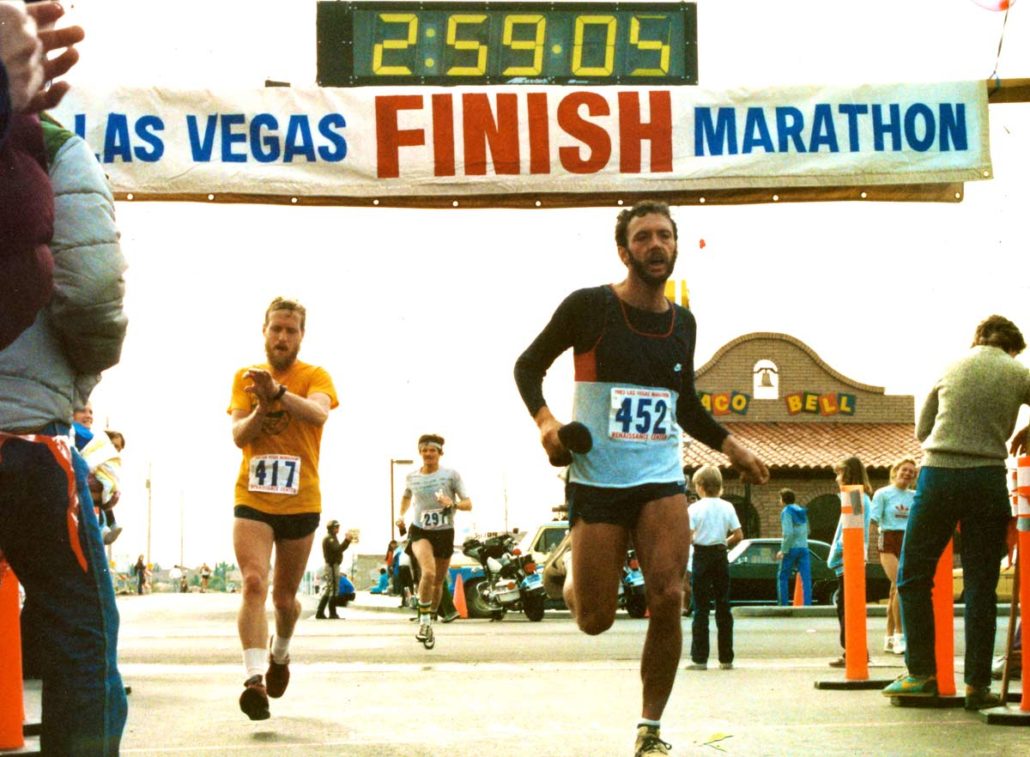Marathon Long Run Part 2

Podcast: Play in new window | Download
Last time, we talked about long runs that were more simple, but not any less easy. This week, we will expand on those foundational types of long runs and into more race specific long runs. These runs already assume that you have built your general endurance and are now into more race specific phases of your preparation. I’ll discuss a few instances where that could change, but for the most part, these are all long runs that would occur after you’ve done general training. I would also say that most beginners and first-time marathon runners should put their focus in being able to cover the ground and then maybe doing these types of runs in the future.
Fast Finish
This was my first introduction into next level training, right here. I don’t quite recall who started it, but my first experience was from Khalid Kanouchi, the Moroccan marathoner and later US citizen. He was a favorite at the Chicago Marathon in the early 2000’s and he would always chat a bit with us Hanson guys at the Chicago races. He told us a staple of his marathon training was the “Fast Finish” long run. A few of us were really on board and begged Kevin and Keith to let us try it and they did! I still remember the day we tried it the first time. We always had a Sunday group run n conjunction with the Stony Creek Running Club and we’d rotate sites. One location was way out on the dirt roads at this middle school in northern Oakland County. It was a tough loop with tons of dirt roads, hills, and the school had a track behind it. So, being who were as a team, hit the long run pretty hard, ran straight to the track, where we had left our flats, and then ripped a 3200 meter (basically time trial against ourselves). I think I ran about 9:50 after putting in a hard 18 miles before. It was hard. It was a real gut check, but it was fun. Part of it was because of the track, part of it was because it was something new. However, it’s not something I’d do all the time! Plus, we definitely made mistakes on that first one, like changing into our racing flats and taking a 5-10 minute break in there. The run evolved for us over time. We don’t change into flats and we just go straight into it from our run. Now, that typically happens where we can let it rip for a few miles down the Paint Creek Trail where the trail is flat.
Some key points to this long run:
- Done in the last 6-8 weeks of a marathon segment.
- I wouldn’t do in successive weeks, follow a tough long run with an easier long run the following week
- Don’t need a lot of these 1-3 during that time is plenty good.
- Really focus on the recovery aspect after these. Pushing yourself to that limit on already fatigued legs will require extra attention from the recovery department.
- From my experience, just getting down to marathon pace is tough enough for most people I have given this run too. No need to make it harder for those chasing BQ’s and new time thresholds. This will still teach you that you can push through late in the game, even when tired and that’s a major component to this long run.
Squires Long Runs
The Squires Long run comes from Coach Squires of the Boston Track Club from the Bill Rogers and Greg Myer era. The long run is a great way to accumulate time at marathon pace for the week, but also bring the average pace of your long runs down. To me, it is a great tool to learn how marathon pace feels throughout the course of time- from when you feel fresh, to when you are tired. This will pay great dividends to those performance minded runners. If you can learn to associate effort to pace and do so when fresh and when tired, you can take your performance to a whole new level! I think this is also a great long run for those who struggle with traditional marathon tempos. We can accumulate a lot of time at marathon pace while not just logging mile after mile at pace every week. However, I have to add, that you do need to learn to be able to do that, but this would be a nice break from that monotony. If you aren’t familiar with what these runs are, they are essentially long runs with a fartlek in the middle to second half of the long run.
- Can actually start these earlier in a training cycle, say 8-10 weeks out from the marathon if you are more of a seasoned marathon vet.
- Use first few miles as a warm up and progress into moderate paces before starting the marathon pace “fartleks.”
- Start with small amounts of time, say 8 x 2-3 minutes at marathon pace with 2-3 minute jogs. Each long run you do, up the time. So, if you do this 3-4 times throughout the training cycle, you may be up to 10 x 7-8 minutes at marathon pace. Ideally, recovery would stay about the same, at roughly 3 minutes.
- Recovery between each marathon pace effort is still in your easy to moderate pace.
- Cool down the last couple miles of your run.
- This is a run you want to be fueling for. Allow yourself to keep the effort high by providing the fuel needed for the intensity.
- Post run recovery is as important as the effort given during the run!
The Combo
If you are in our Facebook group, I have offered this one up for a long time. If you are really tight on time in a particular week, but still have your long run, then this is a great compromise. If you have done the 10 mile tempo, then this is nothing new to you. You have probably done this on plenty of Thursdays already!
- Use first few miles as a warm up, gradually increasing from easy to moderate to long run pace.
- Then do your assigned tempo mileage at goal MP. Ideally this is done for longer tempos, say 8-10 milers.
- Set up so the last 1-3 miles can be used as a cool down.
- This should be a fueled run. You will already be going to the well pretty deep. Don’t dig it so deep you can’t get out.
- Post run recovery is crucial. Get on your refueling, re-hydration, and hopefully, rest as soon as you can.
- If you do this on the weekend, you are typically doing in place of a tempo run during the week, so you may need to adjust the days before and after.
[et_bloom_inline optin_id=optin_4]
The Mega Long Run
Ok, here it is! For all you 40 mile a week runners who love your 20 milers! I am just kidding, so no hate mail, please! I think it is an important long run type to discuss. Now, admittedly, I have never given a mega long run to an athlete, and I don’t have any personal experience with this long run. Just want to be completely up front with you.
The mega long run can mean a couple of things. It can be described in terms of mileage or in terms of time run. When people talk to me about it, they usually express in terms of mileage, usually something like 20-24 mile long runs. If someone does a 22 mile long run using the classic Advanced plan, this is about 40% of the weekly mileage during the last 8-10 weeks of the training plan. If following the plan, the longest long run would be about 29% during the same week.
Sometimes, mega long runs are described in terms of time. For instance, coach Greg Mcmillan says he will prescribe a long run up to 30-45 minutes longer than what the person is planning on running during the marathon. So, if a person is trying to run a 4 hour marathon, then he may give them up to a 4:45 long run. This doesn’t mean that they will cover something like 30 miles because they are running slower than goal pace. They will just be putting in a lot of time over what they plan on racing for.
Do I agree with the mega long run? Well, it depends! I think that when you are new to HMM style training, then no, I am quite reluctant to give the green light on the mega long run. I have just experienced too many people doing it on their own and then not being able to tolerate the rest of the training. Now, if you have done a couple of cylces of our training and seem to be thriving, but need a new stimulus, then I can see doing a run that creeps up into the 40% range of your weekly mileage. HOWEVER, this doesn’t mean you scale way back during the week in order to accommodate this run.
Now, when referring to a mega long run by time, I think you have to look at from a different point of view. If you are following one of the HMM plans and are running long runs at 10 minutes per mile or slower, then a 16 mile long run is already taking at least 2.75 hours. What I think makes that work is that idea that the day before, you are putting in a significant easy run of 8 miles, or at least another hour and 20 minutes. So within about 24 hours, these runners are putting in roughly 4 hours of running. That is a significant amount and stimulates all the adaptations needed that would also be provided by the mega long run by itself. The other aspect I want to look at is from a practical standpoint. Using the examples from above, a 4:30 marathoner (which is about 10:15 per mile), could in theory run 5:15 for a long run. That seems completely brutal to me and I personally feel like that will cause more harm than good. This is because we deplete ourselves so much and begin to break down so much that we really run the risk of being in a position of fatigue that takes way too long to recover from. If I gave a person that run, they would probably be too beat up to do much for the next week! To me, I feel like I can get so much more accomplished from backing the long run down and being able to train the next 7 days as I normally would. I do understand that extraordinary circumstances require extraordinary responses. However, I also think the risk far outweighs the reward for run over 4 hours. Now, where I do see this run working is for runners racing at under 3 hours. Going for a 3-3:30 long run will help these runners, but not dig the training whole too deep. I think a run like that would suit these runners about 10 weeks out from the race and maybe again at about 6 weeks out from the race. As long as they can really put an emphasis on recovery after and fueling during to preserve stores and muscle structure, then I think they will be ok.
Wrapping up..
Phew, that’s a lot of variations to the long run, especially for the marathon. I can’t stress enough that you have to take a serious look at your own ability and where you are at. It’s nice to get some ideas, but you also have to be careful not to get yourself into a position that you can’t recover from later on. If you are a beginning runner, focus on building your general endurance first and then start adding in another training cycle. If you are attempting these types of long runs, put a lot of focus into fueling and recovery. I also suggest that you follow each of these long runs with a more traditional long run. Adding too much intensity and duration for too long isn’t productive either. Keep the balance of easy to hard. Train hard, but recover too.
Love the HMM philosophy, but want to try a new plan? Check out all our options HERE
We also have great coaching options for more personalization! Check em out!





